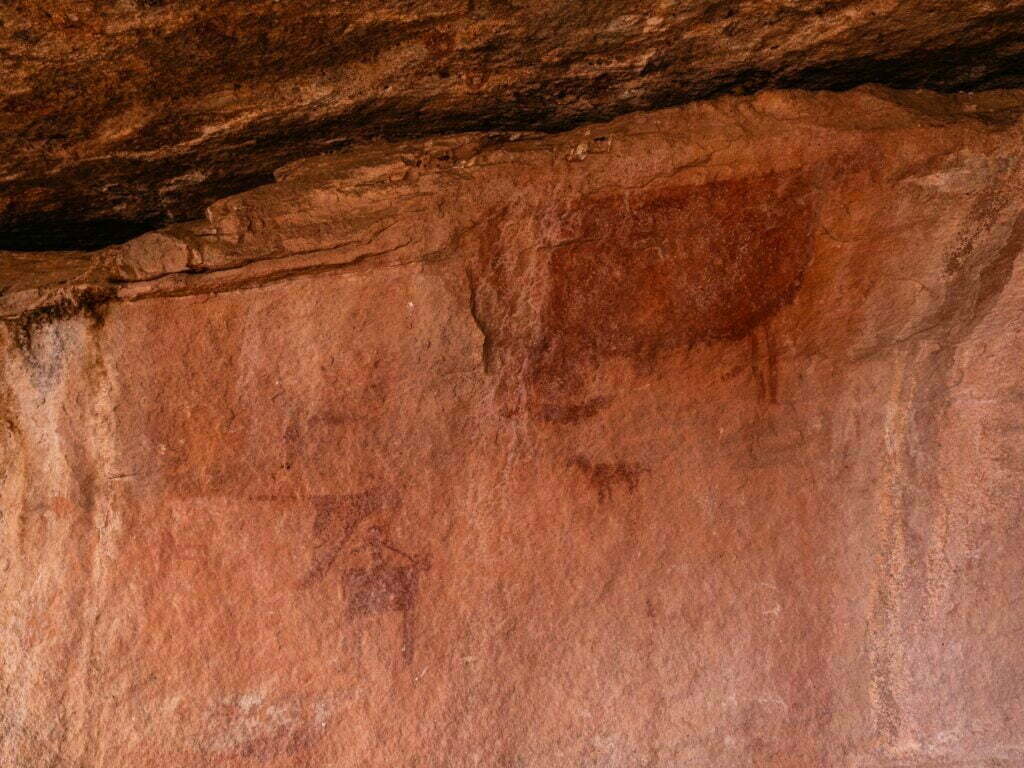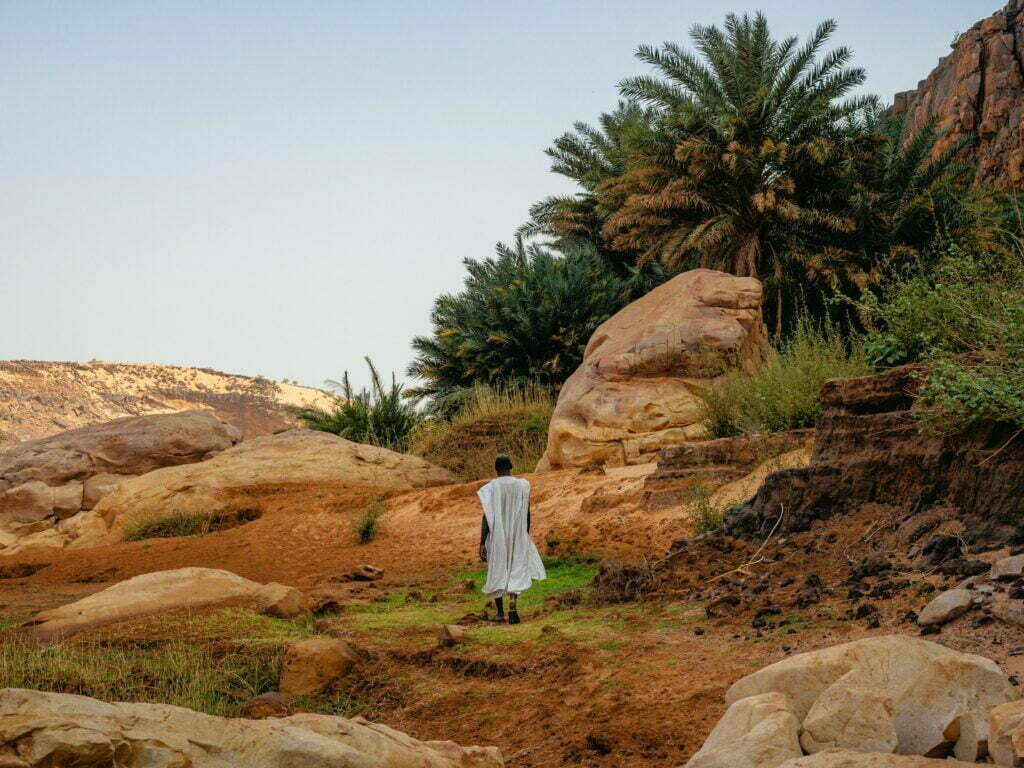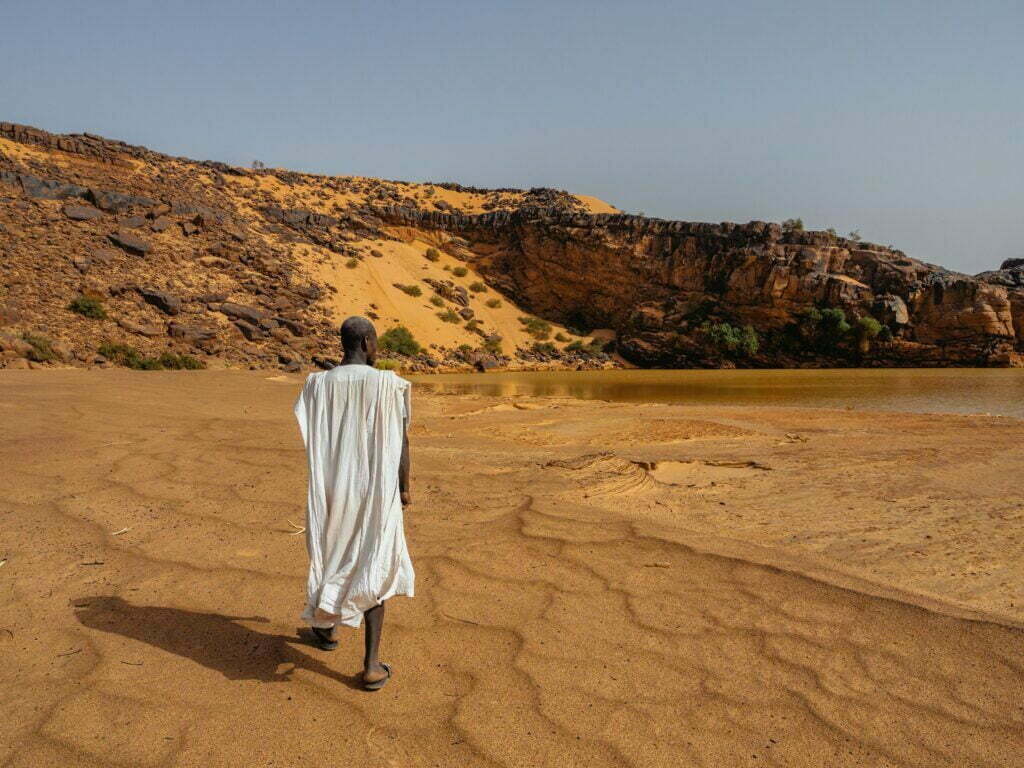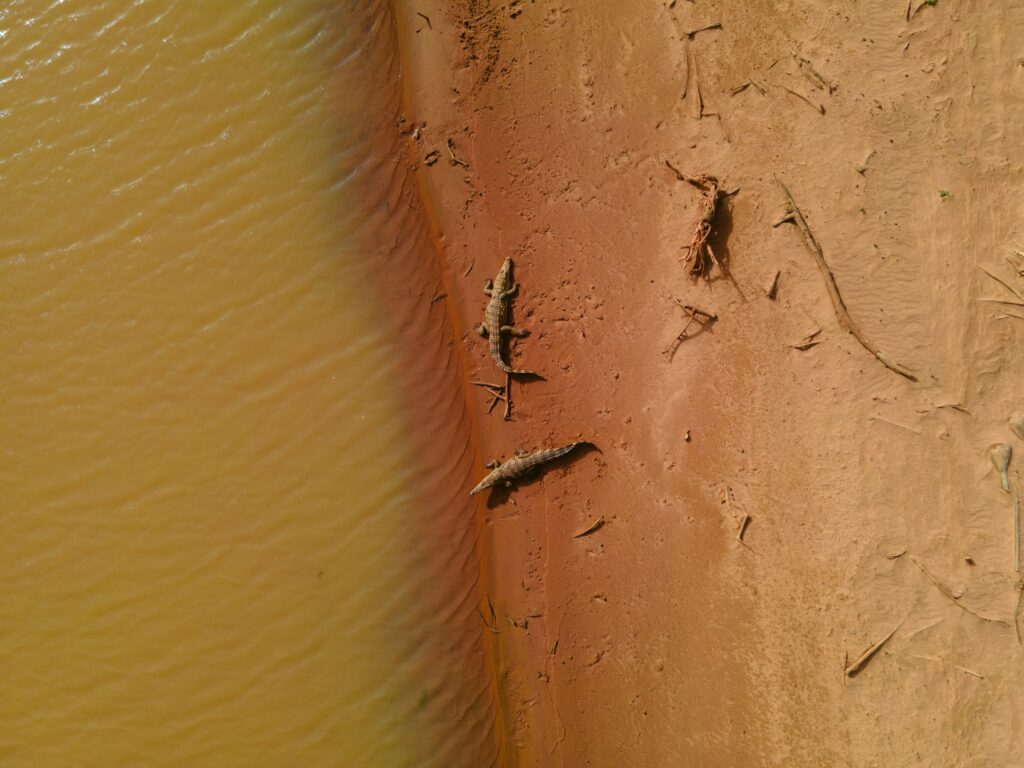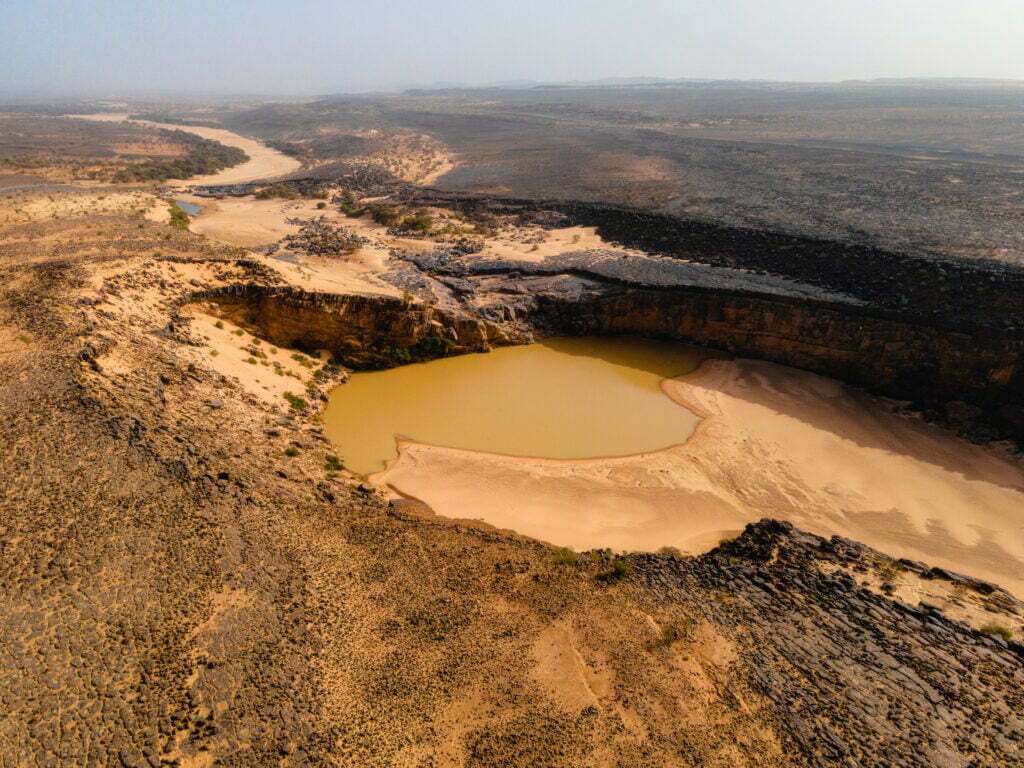
The Sahara desert is an iconic destination, highly renowned for extreme adventures, cultural experiences, remote camping trips, and much more, but, aside from the millions of camels and dromedaries that inhabit the vast land, it’s not really known for its wildlife.
The conditions in the Sahara are some of the most extreme on Earth for both humans and animals, and finding nomads is seldom less surprising than running into any four-legged form of life. The only constant is the flies, those follow you everywhere.
These are things that are known to most people, even to those who will never step foot near the Sahara desert, but it’s truly difficult for our brain to comprehend and imagine total emptiness, you only really get to understand the situation once you’re in it.
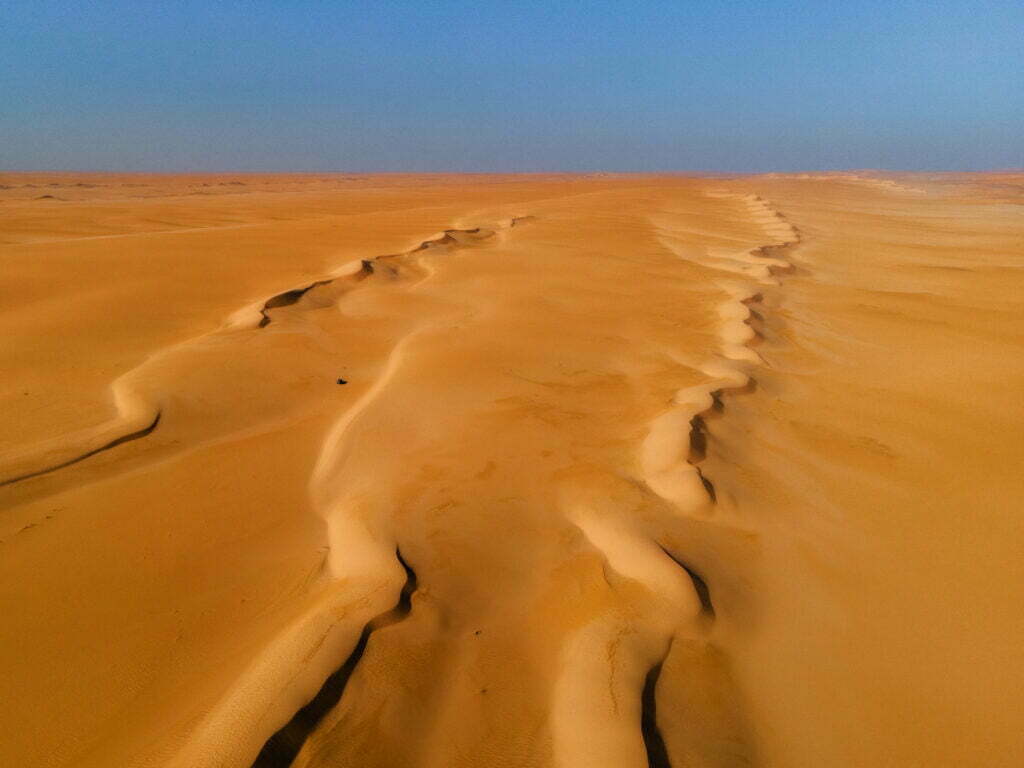
However, every rule and condition has its exception.
What if I told you that right in the middle of Mauritania, a thousand kilometers deep in the Sahara, there are a couple of dozens of crocodiles that date back to when the whole desert was actually full of water and wildlife, and that they are alive and well?
Scientists have discovered that Earth shifts its axis with a pretty regular cadence, roughly every 20.000 years, a phenomenon that results in drastic changes in many areas in the world in terms of climate and everything that follows, such as fauna and flora.
The Sahara is probably the area that went through the most impressive changes, as imagining it as anything other than the harsh and brutal, but still magnificent, place it is today is hard to do.
However, studies show that, from about 10.000 to 5000 years ago, the Sahara wasn’t a desert at all, but rather a green, lush and humid territory, full of rivers and lakes, inhabited by most animals that we know populate Central Africa today, from giraffes and elephants to hippopotamus and…crocodiles!
In Mauritania, wherever you are, it’s probable that you’re either on a river bed, an empty lake, or you can see them in the distance. There are even some areas thousands of kilometers from any form of current body of water that are swarmed with seashells and white sand, signaling the presence of salt.
It’s almost like the mirages you see in these areas are meant to be a little look into the green Sahara that once was, with water and trees at the horizon, merging the present with the past.
However, while it’s easier to imagine and discover that there once was a huge quantity of water where now it’s hard to find a drop, thanks to all the empty bodies of water and the conformation of the territory, it’s difficult to think of huge giraffes and zebras inhabiting these lands.
Bones can disintegrate with much more ease in a place known for its wind and harshness, and after they are gone and mixed in with the sand of the vast Sahara, there really isn’t much out there to help us discover their past.
Luckily, our predecessors were quite smart, and also art inclined. Mauritania has a high concentration of cave paintings, depicting daily scenes, tools, panoramas and, of course, animals.
These are insanely valuable and helpful for us today, but it’s all even more special when you discover them yourself.
Mauritania is probably the one place you’d go if you wanted to make this type of discovery.
An even rarer form of evidence than the cave paintings can be found out there though, in the region of Tagant, the center of Mauritania, and it’s still living.
The crocodiles of Matmata are a uniqueness, as they are one of, if not the only crocodiles left in the desert, dating back thousands of years ago to when these lands were green.
But how did they make it here when every other animal is gone?
Tagant
The Tagant region is a special place, as it feels both like Sahara and Sahel. It’s a mountainous region situated at the center of Mauritania, made up of a set of arenaceous and rocky plateaus from 100 to 450m a.s.l., separated between themselves by gorges and vast valleys, perfect to host the numerous oases of the area.
The Tagant is the only area with bodies of water outside of non-Sahel Mauritania, however, most of them are starting to fade away.

The conformation of the plateau has always helped the Tagant in being an area where water flows naturally, falling as rainfalls to the rock and then like cascades to the gueltas and valleys.
After the earth shifted its axis once again around 5000 years ago, the Sahara started its process of becoming what it is today.
The huge connection of rivers and lakes in the Tagant started to gradually become more feeble, and as the quantity of rain basically fell to zero, it was only a matter of time until the water finished.
Both the scientists and the people who know about the crocodiles at the Matmata Guelta believe that they got trapped there when the connections with bigger bodies of water, such as Gabbou Lake (a 7km wide intermittent lake) got wiped out.
Matmata Guelta

Matmata Guelta is a 4 km long river bed enclosed by the plateau, which narrows down the more you go towards the basin of water containing the crocodiles. The last 2 kilometers are what would be considered a visit to the Guelta nowadays, at that’s where the first small puddle lies. A crocodile or two usually wander through that, but the numbers go up when you walk the rest of the way and reach the end of the Guelta.
Right until a few years ago, as it can be seen from Google Earth’s images and some sporadic photos from travelers, the Guelta of Matmata had a decent amount of water, enough to discourage people from entering it at crocodile level, in fear of running into them. Instead, people used to go watch the basins and the reptiles from above, on the safe and rocky plateau.
However, if you were to visit Matmata right now, you’d find little to no water outside of the only remaining basin, at the end of the Guelta. Unfortunately, the people that live in the village close to the prehistoric animals claim that it hasn’t rained in the past 4-7 or even 10 years, depending on who you ask.
From the village, lying beside the bed of the river that heads to the Guelta, it’s just a few kilometers to reach the start of the walk towards the crocodiles.
At the village there’s always someone that, in the vest of guide, brings people there and guides them through the beauty and dangers along the way.
Upon leaving the village, the scenery transforms into a sort of martian landscape; brown-red sides of the canyon, sand as the pavement, some huge rocks placed without patterns here and there, plus some palms to the sides. The sand is still shaped how a river’s bed is supposed to be, which makes the car bump up and down every second.
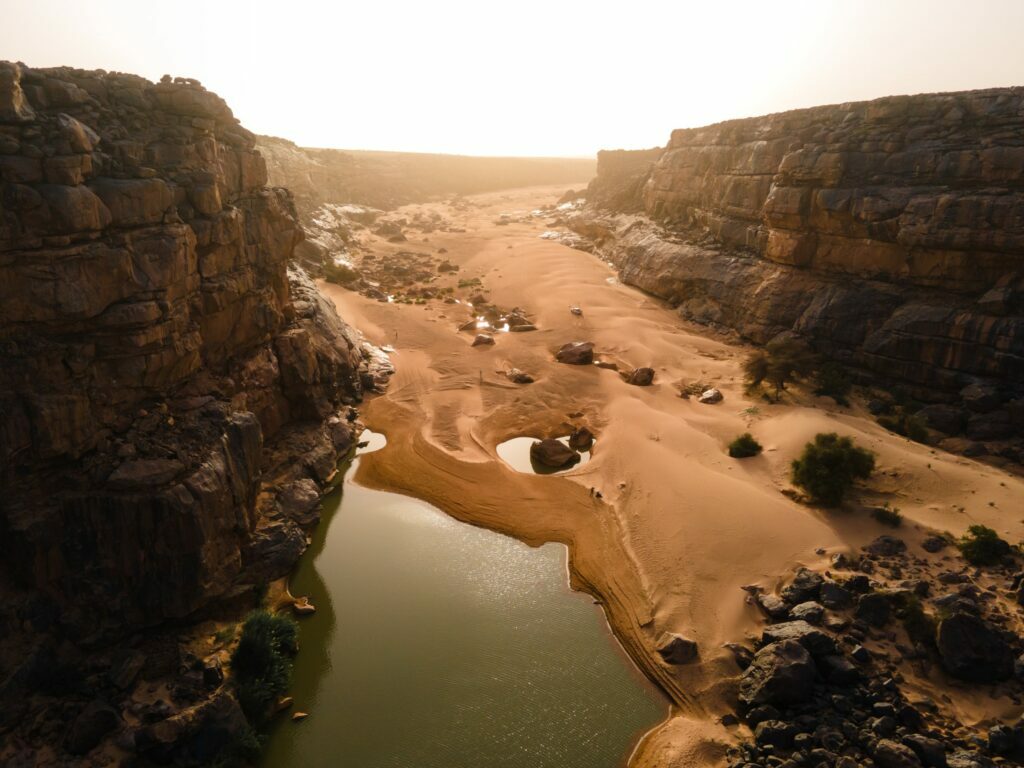
At the end of the wide valley, a narrow passage can be seen, with rocks scattered all around its entrance.
That’s where the crocodiles begin, with the first puddle hosting one or two.
To see them, you have to be gentle, and also lucky. They are a bit shy.

After the first stop there, a 2km walk through the once river has to be made to reach the main basin with crocodiles.
It’s a very entertaining one, starting with an endless army of rocks all along the Guelta, blocking the way.
Once you realize that no crocodile can hide between those, then you’ll actually enjoy leaping through the obstacles trying not to twist your ankles.
The Guelta then takes a turn to the right, which unveils the end of the journey roughly 1.5km away.
If you’re lucky you could also find the body of a dead crocodile right there, slowly decomposing.

The road is then wide open to the end, but there are a few interesting spots on the right side, such as groups of palms on red terrain, nicely contrasting with the rest of the Guelta.
Once the basin is approached, you need to be quiet and alert, not because it’s dangerous but because you’d like to see them before they see you, to observe them in their natural state.
You can even get up close to the basin, right below the 30 meters high plateau walls, as once you’re there and don’t make too much noise, there’s nothing to worry about. Plus, a crocodile’s strength is the water.
Don’t enter it and you’ll be safe.
The Nile Crocodiles
The Nile Crocodile is one of the largest living reptiles on earth. The median size of the animal is about 4m, but some of them grow to an absurd 7m, and their weight can be anywhere between 200-500kg.
It has a massive body and a long, triangular snout. Its skin is generally gray, slightly greenish, black, or brown. Its eyes, ears, and nostrils are located on top of its head, allowing it to see, hear, and breathe when submerged. He is very comfortable in the water but is not clumsy on land, as he is able to reach speeds of nearly 17 km/h.
The animal frequents all the slow-flowing streams and bodies of water on the continent: rivers, marshes, lagoons, water holes, and lakes.
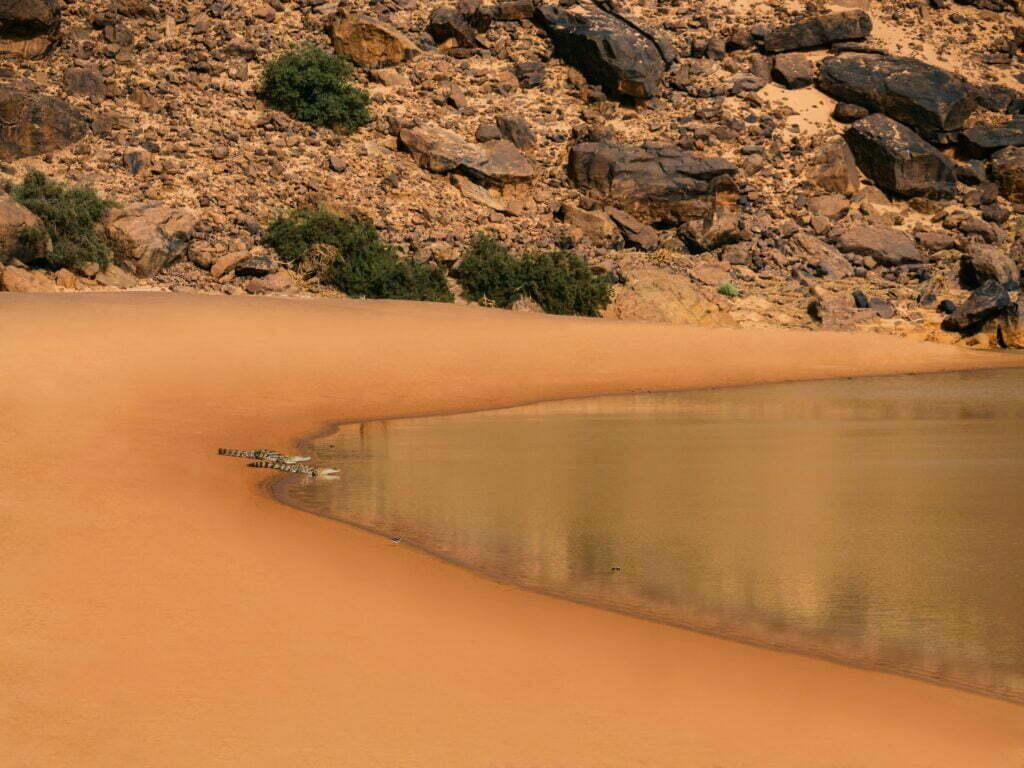
The Nile crocodile is perfectly adapted to the aquatic environment, which it only leaves to warm up or lay eggs. When it hunts, it stalks like all its cousins and waits for the right moment to pounce on its prey. Almost completely submerged, it goes unnoticed by most animals because only its nostrils, ears, and eyes protrude from the water. Its brutal attacks generally leave no chance to its prey, which it carries underwater to drown. The crocodile cannot chew, it shelters its victim under a stump or a stone, so that the flesh putrefies, and will then feed on it by swallowing large mouthfuls. Its metabolism allows it to survive without food for a full year.
The most common question when discussing the Matmata crocodiles is related to what they eat, and it’s a legit mystery, to some extent.
The basin and puddle that host the crocodiles are far from civilization, and the only other animals that wander through this area are little black and white birds and, as some people claim, monkeys.
Of course, crocodiles aren’t able to catch those, and fish don’t just grow spontaneously in those ponds.
Juvenile Nile Crocodiles usually feed on insects, amphibians, and mollusks, but it’s hard to imagine they get many in those conditions.
Most people believe that they then resort to cannibalism, eating each other once they can’t take it anymore. As bad as it sounds, it might be the most probable option.
What’s sure is that most of these crocodiles are smaller than the average Nile Crocodile, and apart from the fact that they are a sub-species, a reason for that could be malnutrition.
Fertilization is internal and lasts two months after mating. The female then lays about a hundred eggs in a nest dug in the sand or under a mound of plant debris. The incubation lasts more or less three months.
When the young ones are born, the female helps them to reach the open air and takes them in her mouth to shelter them in the water. Only 5% of young will survive predators. Some broods are sometimes totally destroyed by ants or other opportunistic animals.
Memories of the past
As you relax and take in the moment, the crocodiles will show themselves gradually. Firstly 3, then 5, 10, 15…they say that about 25 crocodiles inhabit this basin alone.
Witnessing these scenes will make you feel like you’re looking into a frame where the Sahara still shows its lush past. It’s a completely different experience than any other part of Mauritania.
